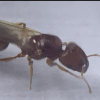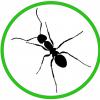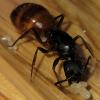May 19th Update
C. anthrax - Still no brood.
C. clarithorax - These are three C. clarithorax queens. The middle tube is the "small" queen, the bottom tube is the "large" queen, and the top tube is the "normal" queen. The "small" and the "large" were found no less than 50 feet from each other, so it can't be a regional difference.
C. essigi - Has some larvae, she also has stopped darkening and also stopped turning translucent.
C. sp. - So recently I was informed that C. maccooki queens are only supposed to be 12-14mm, but this queen is ~20mm; it's up there with C. us-ca02. I can't seem to find any species that has been mentioned in any publication about a species that matches this one, which very exciting stuff! Hopefully I can get majors and be able to place it somewhere on the key I have.
C. maritimus - The one queen still has not produced any brood, but the queen that has now has a couple larvae.
C. semitestaceus - Now the queen has more pupae that she likes to stick to one another with the larvae in the middle.
C. us-ca02 - Both queens now have almost only pupae, there should be workers soon-ish.
C. vicinus - Now with a couple pupae and more larvae than last time.
F. francoeuri - A worker enclosed today and the other pupae are very close to enclosing as well, it's interesting how they came out slightly green-ish.
L. occidentale - Both queens have massive egg piles, if there's no trophic eggs it's going to be quite the numerous first generation.
M. creightoni/tenuinodis - I have yet to key the queen still and I won't be keying it. I've tried a couple times, but I don't have the correct type of microscope. It's one or the other or one other species, but it is most likely not M. yuma since those fly summer and this was caught in spring. One pile of eggs is now larve, the other pile of eggs I suspect are trophic eggs, but they could be just normal.
V. pergandei - There is now two pupae and more larvae.
Edited by ReignofRage, June 26 2021 - 5:00 PM.






















